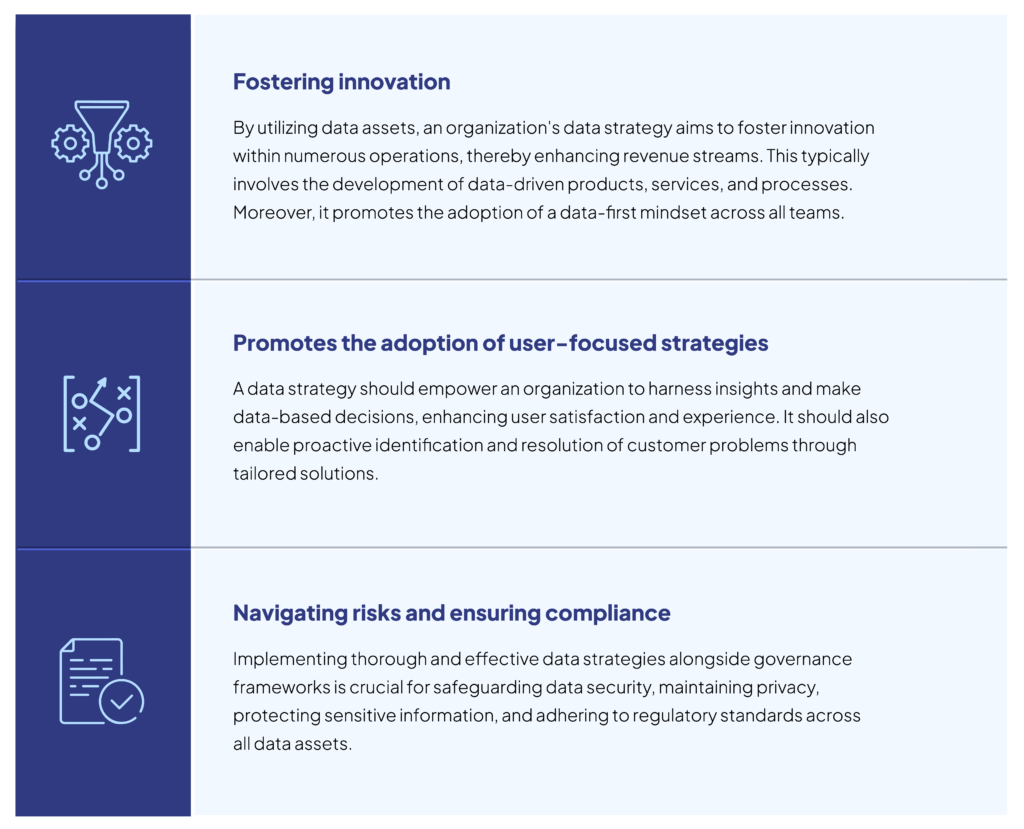Since its inception in 2002, the Chief Data Officer (CDO) role has significantly evolved, becoming a key strategic asset within organizations. According to a 2022 New Vantage survey, there’s been a substantial rise in the adoption of the CDO role from just 12% a decade ago.
This uptick reflects a consensus among business leaders that a strong data strategy is crucial for standing out in today’s competitive and ever-changing market. In the aftermath of COVID-19, the importance of CDOs in ensuring regulatory compliance, unlocking new revenue opportunities through data, and promoting an innovative approach to data use has intensified.
Navigating the complexities of developing a robust data strategy poses a series of challenges, each unique to an organization’s specific needs and objectives. While often daunting, the journey begins with acknowledging that a successful data strategy is not a one-size-fits-all proposition. Chief Data Officers (CDOs) must employ a strategic, customized approach to address these varied challenges effectively.
The purpose of this blog is to explore the common challenges that arise for CDOs while implementing a data strategy and to offer guidance on how to achieve the goals of such a strategy in a sustainable manner. We will also discuss the key data strategy components and emphasize the advantages it can provide.
Challenges to Data Strategy Design
- Lack of a coherent strategic vision: A CDO should have a plan to improve data compliance, security, and privacy, with support from across the organization. An effective data strategy should explain how data can contribute to the organization’s goals while promoting cooperation and boosting efficiency with trust, security, ethics, and responsiveness.
- The challenge of data silos: Compartmentalized data hampers a CDO’s ability to pinpoint data location, ownership, and interrelations, risking data inconsistencies. A strategic overview of the current data landscape is crucial for integrated and coherent data management.
- Organizational resistance to change: To ensure success, organizations must cultivate a culture that encourages data-centric initiatives and unites the organization around data-driven transformation. This is crucial when introducing a new data strategy, as it can stir employee concerns about loss of data control, resource reallocation, and obsolescence.
Data Strategy Objectives
In most cases, the objectives of a data strategy are the main goals that organizations aim to accomplish through efficient management and utilization of enterprise data. These objectives are essential in defining an organization’s data strategy framework and typically include the following:

Blueprint for Executing an Effective and Sustainable Data Strategy

To develop an effective data strategy, CDOs are responsible for sculpting a data strategy roadmap that resonates with the organization’s mission and navigates its unique challenges. Following a strategic planning process comprising pivotal steps provided below can ensure the strategy provides immediate value:
- Mobilize stakeholders: First and foremost, the CDO must rally the organizational troops, forging robust relationships with key stakeholders ranging from leaders to partners. This foundational step fosters a deep understanding of the organization’s mission, paving the path for creating and implementing a strategy seamlessly integrated into daily operations. A comprehensive roster of engaged individuals throughout this process serves as a yardstick for measuring progress.
- Develop a dynamic data inventory to pinpoint deficiencies: Engaging with pertinent teams and individuals will help the CDO discern the data landscape, identifying critical data sets and capability gaps. This endeavor facilitates strategic decision-making and lays the groundwork for essential infrastructure enhancements, ensuring efficient maintenance and updates in the future.
- Reinforce shared values to address challenges: Demonstrating tangible benefits through carefully selected use cases is instrumental in garnering organizational buy-in. These use cases, strategically aligned with the organizational mission, serve as catalysts for change, eroding resistance and nurturing grassroots support among data stakeholders.
- Commit to strategic decision-making practices: The CDO must discern the organization’s strategic objectives and align data investments accordingly, especially in the face of resource restraints. Defining systematic criteria for investment decisions, such as time-to-impact, empowers the CDO to steer investments toward initiatives that promise maximal returns.
- Establish a framework for phased implementation: An adaptable and incremental strategy is essential in a constantly changing data landscape. Regular monitoring and evaluation help guide strategy evolution and ensure alignment with organizational objectives.
- Promote sustained and continuous disruption: A well-crafted data strategy propels organizational transformation, guiding everyone from leadership to staff toward the mission with clarity and purpose. Flexibility and alignment of resources are essential for its success. Through diligent monitoring and adaptive evaluation, CDOs can pinpoint improvement opportunities, respond to shifting demands, and ensure stakeholder accountability.
Pillars of a Comprehensive Data Strategy

A well-structured data strategy is the cornerstone for driving organizational success in today’s data-driven landscape. Comprising four interwoven elements, a robust data strategy seamlessly aligns with business objectives, fosters a culture of data governance, optimizes data architecture, and empowers effective data management practices.
1. Business Strategy Alignment
At the core of any data strategy lies its alignment with primary business goals. To achieve this alignment, organizations must meticulously:
- Identify and document stakeholder requirements, prioritizing insights from customers and executives.
- Evaluate existing data processes and infrastructure to gauge the organization’s data maturity level, laying the groundwork for strategic planning.
- Establish clear short-term and long-term data strategy goals, each tethered to quantifiable objectives that directly support business imperatives—for instance, setting short-term targets for data backup frequency and long-term aspirations for ROI enhancement based on current data investments.
2. Defined Organizational Roles
Clarity in roles and responsibilities is paramount for the seamless execution of a data strategy. Critical steps include:
- Identifying and appointing data stewards, owners, managers, analysts, engineers, and architects to fulfill specialized functions.
- Cultivating a culture of data governance, wherein all data-related activities are orchestrated under the guidance of a Chief Data Officer or Chief Data and Analytics Officer, leveraging relevant teams and resources.
3. Robust Data Architecture
An effective data strategy encompasses the design of a modern data architecture, addressing various facets such as:
- Selection between data warehouses, data lakes, or hybrid solutions to accommodate diverse data needs.
- Adoption of data fabric or data mesh architectures for seamless data flow across teams and systems.
- Utilizing data catalog and metadata management tools to streamline data assets, facilitating efficient integration and processing.
4. Comprehensive Data Management
A holistic data strategy incorporates diverse data management procedures, including:
- Data virtualization, enabling teams to gain a comprehensive view of organizational data.
- Data democratization, empowering cross-functional teams with access to data, fostering a data-driven culture.
- Leveraging advanced platforms to simplify data democratization efforts.
By integrating these elements into a cohesive strategy, organizations can unleash the full potential of their data assets, driving innovation and fueling corporate growth while maintaining alignment with overarching business objectives.
Data Strategy Impact on Business Outcomes

By crafting a precise data strategy, companies can significantly enhance their capability to harness data for increased business profitability. Some of these benefits include:
- It provides a strategic edge: Data, as a strategic asset, can give organizations an advantage in a highly volatile market. It lets enterprises quickly identify new trends and opportunities within their customer data. They can make informed decisions about uniquely improving their products by using data-driven insights. This helps organizations to meet their customers’ needs and attract potential customers more effectively than their competitors.
- It optimizes decision-making: A survey conducted by Salesforce in September 2023 revealed that 71% of data leaders concur that data is crucial in reducing ambiguity, leading to precise decisions in business conversations. Data-driven analytics give decision-makers insights into their organization’s performance, customer preferences, and market dynamics, enabling them to make quick and informed decisions aligned with their goals.
- It enhances work efficiency and productivity: A clear and well-defined data strategy can significantly improve an organization’s productivity and efficiency. As such, many business leaders believe data helps employees focus on critical business aspects. Data integration and automation pipelines can help organizations reduce manual and repetitive tasks, minimize errors, and save resources. As a result, data teams can focus on higher-value tasks, leading to more innovation.
- It helps to coordinate data management efforts: An efficient data strategy is crucial for collecting, storing, and analyzing data while making sure that data management initiatives of an enterprise are in line with its objectives. This also involves breaking down data silos by promoting collaboration and integration across different departments.
- It ensures compliance: Navigating the digital frontier demands rigorous cybersecurity and compliance measures within your data strategy. Essential regulations like GDPR, CCPA, and HIPAA dictate strict guidelines for safeguarding sensitive information. The stakes are high, with the cost of data breaches averaging $4.35 million in 2022, according to IBM. The consequences of failing to protect customer data stretch far beyond financial implications, risking reputation and legal standing, thus underscoring the criticality of robust data security to ensure trust and compliance.
Conclusion
In conclusion, crafting an effective data strategy is not without its hurdles. A bespoke approach is required to implement a data strategy that meets an organization’s unique needs. This blog offers valuable insights on overcoming obstacles and successfully implementing a data strategy. It highlights that there is no one-size-fits-all solution; instead, a customized, strategic approach is crucial for unlocking the full potential of data’s transformative power.
To succeed, enterprises of all sizes and industries must adopt the right approach to data management. By doing so, they can unlock their full potential and drive innovation, efficiency, and competitive advantage.
At AppsTek Corp, our expert consultation and strategy services can help CDOs chart a strategic course, ensuring a seamless and efficient experience. Contact us now.


